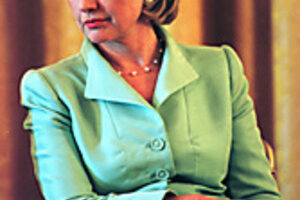Clinton's White House schedules revealing, not definitive
The 11,000 pages released last week shed little light on her readiness to be president.

Looking back: Sen. Clinton was a strong advocate of healthcare reform during her tenure as first lady.
andy nelson – staff/file
Washington
To a casual reader, Hillary Clinton's newly released White House schedules may raise a pointed question: Why does she want to go back?
Sure, living at 1600 Pennsylvania Ave. has obvious perks, according to the details of the 11,000-plus pages made public so far. Queen Noor of Jordan occasionally drops by. There are lots of references to "Air Force One" and "motorcade."
But – with the notable exception of the Clinton administration's healthcare initiative – the schedules reveal little about any substantive work of Ms. Clinton's White House years. They are instead the record of the drudgery that comes with high public life – endless photo ops, hospital and school visits, and commemorations planned out to the minute.
The record notes, for instance, that on Monday, April 12, 1993, at 9:50 a.m., Hillary Clinton (and Bill) received a commemorative Easter egg from the chairman of the American Egg Board and representatives of the Arkansas Poultry Federation, "on behalf of the nation's egg producers."
This was followed by two different receptions and then, at 10:40, a stroll to the south lawn, and the annual White House Easter Egg Roll.
On May 13, between 3:00 and 3:50 p.m. in the White House East Room, Hillary Clinton held a Christmas card meeting.
Perhaps it was difficult to choose a wintry scene at the height of springtime. On May 25, the committee met again. "NOTE: NBC crew will be filming first part of meeting," reads the schedule.
The documents released by the Clinton Library on March 19 for the most part only detail public meetings or those set up in advance. About one-third of the pages have some parts blacked out, and what remains are only schedules, not transcripts, or talking points, or notes, or in any way an indication of what Senator Clinton thought or learned or expressed during her husband's two terms in office.
They may have little bearing on whether she would make a good president.
But the daily entries are revealing about the nature of White House life itself.
First, they hint at the enormous effort that is involved in the work life of the staff.
For instance, the Clinton administration's healthcare reform initiative must have produced enough paperwork to blanket Arkansas. Throughout 1993, Clinton was involved in endless healthcare briefings, many with some 20 participants, each with their own prepared remarks, followed, usually, by a discussion period.
Clinton also held healthcare rallies from Montana – where Sen. Max Baucus presented her with a 30-pound "Hornaday Buffalo Bill statue" – to Massachusetts, where the public meeting was preceded by a surprise birthday party for Sen. Ted Kennedy.
Second, the endless rounds of public appearances reveal how the first lady (and/or the president) were required to appear upbeat and interested at every event, until the schools and hospitals must have started to blur together.
To the vested, such appearances boost morale. For Hillary Clinton, it may have been like being Queen of England – without the inherited majesty or the jewels.
On May 26, 1998, for example, Clinton visited a school in Danville, Calif., where she observed a class "participating in a trust-building activity, learning on the Internet, and playing with Lincoln Logs."
On June 5, Hillary and Bill Clinton visited the Thoreau Institute in Boston, a foundation dedicated to research on Henry David Thoreau and to preserving the woods around Walden Pond.
They participated in a video teleconference with local students. The schedule notes that a student named Liz Coogan was to ask the first lady, "What is the significance of Walden Woods and the works of Henry David Thoreau to you?"
Given her apparent love of academically-oriented facts and figures, that's probably a question Ms. Clinton hit out of the park.
